Abstract
On university campuses, retrofitting studies have historically concentrated on individual buildings (or building components) instead of the entire campus. In the present paper, we examine how an incorporated strategic planning strategy might be used to investigate the socio-technical construction of a campus retrofit operation throughout multiple scale/sectors. The campus of the University of Oradea (CUO), Romania, with its beginnings in the 1910s was investigated using its new master plan. The developed strategies for a “green” and “healthy” campus depict a CUO redesign involving complex solutions for the green renovation of old buildings. In addition, the improvement effects of the modernization interventions already carried out were analyzed and quantified. Sixteen buildings (30% of the built area) were consolidated/rehabilitated/modernized, and/or equipped in the last decade, seven educational spaces being included in the circuit of the buildings fund (totaling 5491.59 sq m). For the renovated spaces, energy consumption was reduced by 20–88% and CO2 emissions by 41.82–86%, depending on the specifics of each space. The reconfiguration, rehabilitation, and energy efficiency of the entire heating system of CUO (which uses geothermal water as a specific characteristic) significantly improved (20% decrease in energy and 21% decrease in geothermal water consumption). Our findings offer new directions and design solutions for the ecological modernization of other outdated university campuses, highlighting new perspectives in the green university campuses’ management, as a way to implement sustainability in the higher education environment. Data presented give professionals in the field (architects, designers, engineers, planners, and decision makers) a clear picture of the benefits due to ecological renovation, also offering the necessary tools to implement new solutions for reducing the impact of urban areas on the environment.
1. Introduction
Rehabilitation of existing buildings, taking into account compliance with ecological construction requirements, leads to improvement of the environmental attributes of the buildings [1]. Therefore, this sector has great potential to reduce CO2 emissions since traditional buildings increase environmental pollution by generating a large amount of waste during their life cycle [2,3]. Globally, the construction industry consumes 40% of total energy production, 12–16% of all water available, 32% of nonrenewable and renewable resources, 25% of all timber, 40% of all raw materials, produces 30–40% of all solid wastes, and emits 35–40% of CO2, which has resulted in a rising global awareness of the importance of sustainability in the construction industry [4]. Therefore, the reduction of emissions in the field of construction is necessary to mitigate climate changes, which are already extremely noticeable [5,6,7].
The past decade has witnessed an increased interest in sustainable, healthy, or green building (GB) concepts and practices across the globe [8]. Generally, sustainable building design considers the impact of buildings on their habitat from multifaceted dimensions, including ecology, economy, and society. It involves formal as well as informal initiatives expanded by private industry, professional organizations, and governments. Such endeavors have resulted in the development of improved energy codes, low environmental impact materials, design guides, renewable energy and resources, and the concept of analyzing consequences of design choices over the building’s entire life cycle [9,10].
Academic institutions dedicated to education, research, and community services, can have a particularly visible and important role in sustainable development, as well as in the management of measures taken to mitigate/stop climate change [11,12]. Moreover, universities have a fundamental role in helping society understand and get involved in the current environmental conditions and climate change. The challenges mentioned by the international frameworks (i.e., Green Deal [13], the framework for achieving climate neutrality [14]) are focused in the short/medium term on achieving climate neutrality. In the current period, numerous higher education institutions have clearly established objectives that are based on sustainability, emphasizing the role of universities on the path of transforming the environment in which people live and carry out their activities towards sustainability. Most of these initiatives are carried out through operational activities, to raise awareness among interested parties, but also through educational and research activities (e.g., greening/cleaning of campuses; curriculum redesign; strengthening of networks built in local/regional/continental/international areas, etc.) to positively influence human behavior and attitude towards the environment [15]. Mutual cooperation between different stakeholders can contribute to the improvement of sustainable development activities [16].
The green campus can thus be seen as a community with the unitary goal of increasing the efficiency of energy use, supporting, and saving natural resources, improving the quality of the environment, etc. It is obvious that these objectives can only be achieved through an education focused on sustainable development, as well as implementing projects based on a healthy, ecological lifestyle, and with care for everything that surrounds us [17].
Considering the above, the ecological modernization of old buildings must be seen as an effective solution, with a practical approach, in view of sustainable urban development. The retrofitting of old buildings is different from the modern design given to new ecological buildings, emphasizing the location of the site within a settlement (urban or rural), adaptability, functionality, technology, and taking into account the existing climate [18].
Due to its complex heritage, Romania possesses many remnants of its cultural history. The architectural heritage of the University of Oradea is a significant component of the local cultural heritage, though a part of it still needs to be acknowledged, restored, and preserved [19,20].
Sustainable retrofitting and green restoration of old buildings on university campuses began to receive considerable interest because of their promise to enhance energy performance and decrease emissions of greenhouse gases, but extensive research is required due to the limited number of publications on this subject [21,22].
Researching the scientific literature to identify publication trends and research gaps is essential in this promising field for a future based on sustainable development. In this regard, the relevance of the topic chosen for the study was assessed by applying search algorithms in three large and scientifically validated databases (i.e., SpringerLink, ScienceDirect, and Web of Science). The results displayed in each database (Figure 1) underline the low number of publications that have addressed the concepts of green retrofitting, ecological renovation, and geothermal water as a heating agent; moreover, when using the Boolean operator AND, which filters and associates these concepts with university campuses, the results obtained are even more drastically reduced, reaching only one result displayed in a Web of Science search. Moreover, the whole working context applied to the situation in Romania shows a major deficit of publications evaluating university campuses in these integral parts of sustainable development, thus identifying certain knowledge gaps. In Romania, there is a significant gap in knowledge regarding the need for green retrofitting studies of old buildings on university campuses. The only resulting paper identified in the Web of Science for the application of geothermal water as a heating agent in university campuses in Romania belongs to a part of the authors’ collective [23], the use of geothermal water in renewable energy is an essential and rare aspect for a university campus in general (no paper in the world provided studies related to retrofitting buildings in a university campus, built in different years during more than a century, some of them changing their initial function, and heated with geothermal water), and even more so for a “green” one.
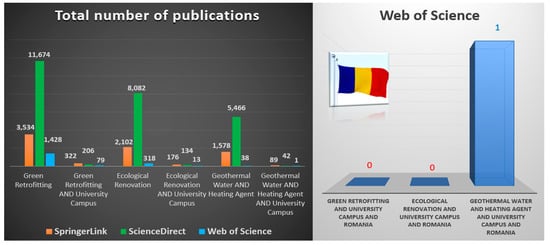
Figure 1.
Linking the very low number of publications evaluating the green renovation/retrofitting of university campuses, and especially in the case of the deficit registered in Romania, with the identification of the research gap and the need for new research.
The idea of this study came naturally from the current context detailed above and from the daily needs of the campus of the University of Oradea (CUO). The main purpose of the research was to analyze the works in progress dedicated to the modernization of this 150-year-old campus, a campus developed in different stages and periods. Another goal was to summarize coherent and effective principles for approaching the conversion of an existing urban complex, with a certain functionality (such as a university campus) into a “green” built complex (“green” campus), in which daily activities are carried out in a healthy way. The authors aim to demonstrate that this is achieved at the micro level (for example through interventions in each building) as well as at the “macro” level, through a global and holistic approach, on various levels, through integrated management.
The present study proposes a distinct approach to address some of the research gaps identified in the literature search process by applying sustainable development principles to the design of a green university campus and highlighting the advantages offered in a distinct way, since as Figure 1 shows, it is the first of its kind in Romania (meeting all the key points we have approached in this research—e.g., green retrofitting of numerous buildings with multiple uses, ecological renovation of very old buildings whose prior utility has not been correlated with the university, as well as the application of renewable energy principles through the implementation of geothermal water as a heating agent, with application to an entire university campus). Hence, the suggested approach can serve as a useful guide for finding viable retrofitting solutions for both older and more contemporary university campuses, as well as other campus types that match this perspective.
2. Materials and Methods
2.1. Presentation of the University Campus
The CUO, located in northwest Romania, latitude: 47°02′26.40″ N, longitude: 21°55′7.19″ E [24] (Figure 2), is very close (17.1 km) to the border between Romania and Hungary, is almost 150 years old, was originally intended as a Gendarmerie School [25], and has developed and expanded over time.

Figure 2.
Satellite image of the location of University of Oradea, Romania.
The current campus is a complex urban architectural composition, which includes the historic campus and later buildings. The historic campus is composed of a unitary urban architectural ensemble, Category A—historical monument (architectural monument of national interest from a value point of view) [26], the reference work of avant-garde secession by the architect Vágó Jószef. Around it, in different stages, the Pedagogical Institute campus was developed (between the 1960s and 1970s), and later the buildings of today’s UO were built (in the years 2000–2010).
In the last decade, the management of the UO has focused on renovation, rehabilitation, modernization, and retrofitting of existing buildings. All these activities are part of the extensive development actions of a green campus, remaining at the same time focused on the legislation/directives in force [27].
The study was carried out on the site of the Central CUO, which occupies a land area of 222,307.00 square meters (sq m). A satellite Google Maps image [28] of the site is presented in the Figure 3. The existing buildings on this site have a constructed area of 33,456.74 sq m, with various height regimes (one to five levels) and a developed area of 90,002.40 sq m. The buildings were constructed with different concepts, having different structures, depending on the stage in which they were built; consequently, for exploitation, they have different consumptions.
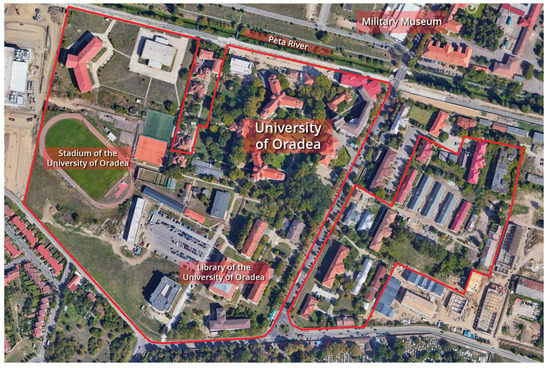
Figure 3.
The site of the Central Campus of the University of Oradea.
The interventions on the infrastructure of the university campus, highlighted mainly in the present paper, refer to the retrofitting of some buildings with an age of 100 years, but also to the thermal and/or energetic rehabilitation of other buildings, all of which represent a quota of 30% of the area of existing buildings. This specific building was part of the “Smart Campus University of Oradea” project, financed both from European funds and from its own revenues.
2.2. Data Analysis
The method of the study consisted of several stages following the master plan of the campus. To begin with, data analysis was conducted by focusing on the existing documents in the state archives, university documents, European, and international directives in the context of the study [23]. This stage involved the identification and description of the strategies and solutions for a “green” and “healthy” campus, created and implemented by the UO management in various stages of the reconversion or rehabilitation of the buildings under study. Next, the results obtained from the retrofitting of very old buildings and the thermal and/or energy rehabilitation of other existing buildings were analyzed. To this end, existing documentation at the General Administrative Directorate/Sustainable Campus Directorate of the UO was consulted and studied, as follows: the “Smart Campus—University of Oradea—stage I” project, from whose Energy Audit [29,30,31] (including the Energy Performance Certificates from both the beginning and from the reception of the rehabilitation works of the E-F body were considered [32]), interpreting their results and observing the differences in the parameters. Later, the indicators provided by these certificates were used to calculate the impact of the interventions to be modernized on energy consumption and CO2 emissions, comparing the values of initial parameters with those resulting after the rehabilitation. Thus, the results of energy efficiency were studied on a developed built surface of 7915.29 sq m.
From the “Smart campus—University of Oradea—stage II” project, information was taken from the historical study. The campus network rehabilitation project and how to implement it was studied. Data on consumption monitoring from existing reports within the University’s Investments and Consolidations Office were analyzed, processed, and interpreted. Based on the records of consumption before and after the thermal rehabilitation, the impact of the thermal rehabilitation on the thermal energy consumption was calculated.
To provide solutions for the construction/rehabilitation of a building to become a GB, as well as for the solutions for the development of a green campus, the authors of the paper corroborated the information of the indicated references with those of the energy efficiency projects implemented in the UO.
3. Results
3.1. Strategies and Solutions for a “Green” and “Healthy” Campus—The Case of the University of Oradea
Starting from 2013, the management of the UO, at all its levels, was oriented towards creating a sustainable education by transforming the existing campus into a “green” and “healthy” one. At this stage, the investments were dedicated especially to the thermal efficiency of the buildings. In the following years, a new stage, with a better determined trajectory towards a “green” and “healthy” campus (with more complex works related to its infrastructure) took shape; therefore, through a holistic approach, Oradea City Hall, in collaboration with the UO’s management team, developed in 2018 a sustainable development strategy for the university, respectively a regional urban plan called “Masterplan” [33].
The project was developed by an architect with European experience in the design of university campuses, and it states that, “The concept starts from the idea of a green spine with the role of a connector along the entire length of the campus. This spine unites the historical part of the campus with the proposed new areas, giving the whole complex a unitary aspect from a compositional point of view. The proposed new functions relate to the existing ones through an integrated system of public and green spaces”. A figure from this Masterplan presents the approach to the project (Figure 4) [33].
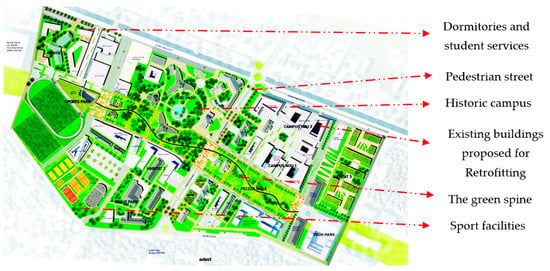
Figure 4.
Masterplan—Campus of the University of Oradea. Reprinted/adapted with permission from Ref. [33]. 2023, Năstase, R.P.
From the point of view of the infrastructure (buildings and their related utilities) of the university campus, the management team’s actions focused on:
- Efficient use of the existing buildings fund and their “recycling” through:
- –
- Structural rehabilitation;
- –
- Introduction into the circuit of educational spaces of buildings abandoned over time and unused with their reconversion;
- –
- Application of GB principles to all interventions on the existing buildings, through the actions described in Figure 5 [34].
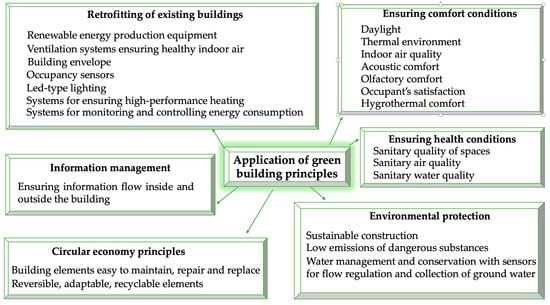 Figure 5. Application of GB principles.
Figure 5. Application of GB principles.
- Imposing the “Green”, “Smart,” and nearly zero energy building “NZEB” criteria on new constructions proposed during the design, execution, and operation period.
- Efficient use of renewable energies: existing geothermal water on the CUO site, geothermal energy (use of ground-water heat pumps), outdoor air energy (air-to-air heat pumps), solar energy (photovoltaic panels).
- Instituting an integrated system to ensure heating of the buildings of the entire campus. This is possible through efficient use of the existing renewable energy source on site: geothermal water as the primary agent, residual geothermal water with the equipment of thermal plants with heat exchangers and heat pumps [8].
At the same time, in the context of the circular economy and protection of the environment, re-injection of residual geothermal water into the custom drilled locations was ensured. Consequently, two thermal power plants were equipped with heat exchangers for use of geothermal water as the primary agent and high-performance heat pumps equipped with monitoring and control systems for the use of residual geothermal water. The principles are illustrated in Figure 6.
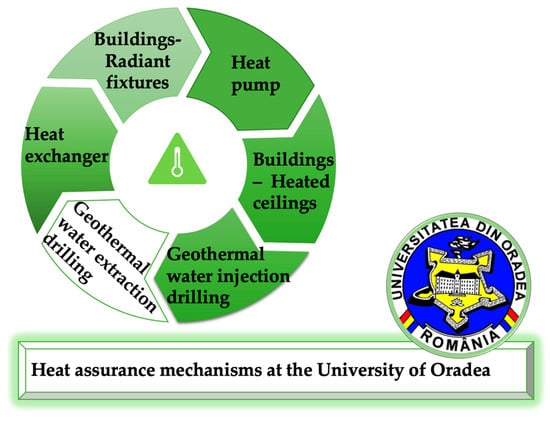
Figure 6.
Principle scheme for ensuring heat for the University of Oradea Campus.
Another series of important measures for development in a sustainable context are:
- Metering of buildings (thermal energy, cold water, hot water, electricity).
- Rehabilitation of external heating networks and sanitary networks (cold water, hot water, and wastewater).
- Putting into operation a system of rainwater recovery to be used for sprinkling green spaces and outdoor sports fields.
- Implementation of an integrated and efficient IT system, considering the explosive growth of information, the emphasis on digitization, which involved numerous resources (facilities, hardware, infrastructure, energy, personnel). UO data centers have significant annual consumption, but there are studies showing that energy savings can be achieved (about 46%) using integrated concepts, residual heat, and optimized operating temperatures [33].
Data and communication are essential to the conduct of UO activities [35]. Hence, for efficient operation at the university level, an intranet and extranet communication solution is provided based on a wide range of latest generation technologies that ensure safe, high-speed access. The IT services offered in the context of UO (Figure 7) conditions offer both high quality and appropriate information/data security [36]. The solutions implemented by the IT department offer both a high level of security and confidentiality of information/data, constituting a true spine for the development of a real smart campus [34].
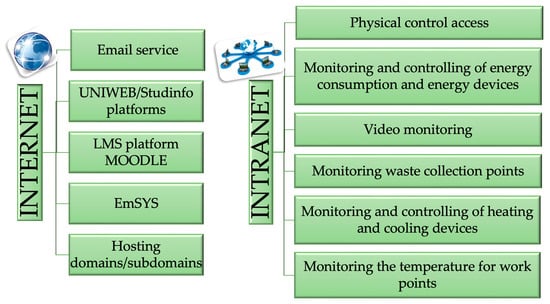
Figure 7.
IT services for UO.
From the point of view of applying the principles of a circular economy, waste management is implemented (organic waste treatment, inorganic waste treatment, toxic waste treatment, and sewage disposal). The waste management programs within the UO are designed to reduce pollution, protect and be friendly to the environment, as well as to encourage recycling by the whole community. Current and future waste management policies at the level of any institution are intertwined with the waste management strategy of the locality of the institution. Considering both the constant decrease in the cost of new technologies and the numerous wireless software/technologies available to facilitate the intelligent management of waste, UO is considering substantial improvement of the current management system of all types of waste [37], since in the CUO, 15 faculties carry out their activity, and some of them (Faculty of Medicine and Pharmacy, Faculty of Sciences (including Chemistry, Biology), Engineering, etc.) produce specific waste (tissue samples, medical and pharmaceutical [38,39], chemical, electronical, etc.). This vision is also included in Figure 7. At the same time, the UO’s sustainable development strategy includes a program to reduce the use of paper and plastic on campus.
When rehabilitating existing buildings and constructing new buildings, as well as during the phase of ensuring mobility within the campus, facilities for people with disabilities, special needs and/or maternity care are considered.
From the point of view of the distribution of urban green space, through the Masterplan (Figure 4) a “green rail” is proposed, which increases the existing generous green area, by abolishing morally and physically worn buildings. Their rehabilitation would be unsustainable. The considerable number of trees on campus contribute significantly to the air quality, comfort, and health of campus life. In the CUO, there are protected plant species, which are given special attention. A dedicated service ensures the maintenance of the university’s green spaces.
In terms of ensuring mobility within the campus, special attention has been paid to the arrangement of pedestrian walkways, so that vehicles have access only to the parking lots arranged in the marginal areas. Bicycle parking racks are distributed around the campus and an electric scooter station is interconnected with the city network. The municipality extended the tram line from the city to the campus, thus ensuring easy and non-polluting access to the CUO. Through the same Masterplan (Figure 4) it is proposed to close the street that currently divides the campus into two areas, by transforming it into a pedestrian street.
Regarding study programs dedicated to sustainable and intelligent development, the following are offered at the UO:
- –
- Degree program: “Engineering of renewable energy systems”;
- –
- Master’s programs: “Smart and sustainable constructions”, “Environmental management, evaluation, conservation, and protection”, “Renewable energies”, “Energy systems management”, “Biodiversity and ecosystem monitoring”, etc.
In other study programs, disciplines applied to sustainable development and climate change, regarding the circular economy, are supported.
The teaching philosophy encourages friendly explanation and understanding, as well as tools using some of the most advanced technologies. The university is equipped with smart boards, video projectors, 3D printers, and other appropriate equipment (Figure 8).
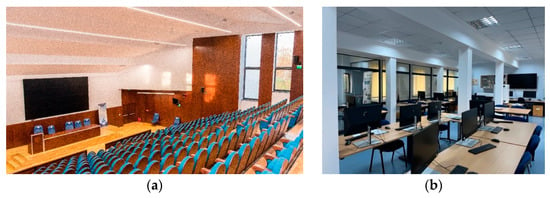
Figure 8.
(a) “Aula Magna”; (b) “Smart Mat” laboratory.
In addition, within the university, two educational platforms (“eLearning—Moodle” and Microsoft—Teams platform) are operable through which teaching activities can be carried out under the best conditions. The UO’s IT service is available to assist both teaching staff and students in their operation. At the same time, as shown in Figure 7, a platform created by UO is operable, namely Studinfo/UNIWEB platform, for management of didactic activities with students (grades, fees, etc.).
For economic and administrative management, related staff are trained to use dedicated electronic/computer applications. Special interest is currently given to digitization, which is supported by European funds for which the UO applied.
Regarding research-innovation activity, through the Oradea University Library, students and teaching staff have access to the “Anelis Plus” database, which connects them to the latest publications. This activity is stimulated by the university by awarding authors of innovations, valuable articles, students participating in various competitions, or conferences.
In the geopolitical context of today, the University of Oradea has all the tools to carry out its activity both in a pandemic situation and in other extreme/special situations. In the CUO, conferences, scientific and cultural activities, and extracurricular activities are organized in which students and teaching staff are trained, so that life on the student campus is harmonious, balanced, and attractive.
The administrative management of the university has special involvement in maintaining the existing sports fields and in developing a sports base, ensuring to the students and teaching staff the possibility of accessing them both during sports classes and during the time dedicated to recreation.
The opening of the UO to internationalization provides another corridor for students and teaching staff towards an attitude anchored in European and world current affairs.
3.2. Results following Intervention on Existing Buildings
Table 1 highlights the consolidation/rehabilitation/retrofitting, modernization/endowment activities on 16 existing buildings, during the last decade. These buildings represent 30% of the developed built surfaces existing in the CUO. Example of Energy Performance Certificates (for the original building vs. the thermally + energetically rehabilitated building) is presented in the Figure 9.

Table 1.
Interventions on the infrastructure of the University of Oradea Campus (buildings) from 2012 to present, by results.
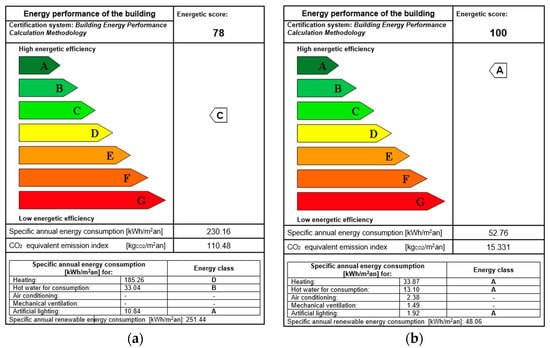
Figure 9.
Energy performance certificate: (a) initial building; (b) thermally and energetically rehabilitated building.
3.3. Results following the Retrofitting of Seven Buildings on the CUO
In the last decade, seven educational spaces were added to the circuit of buildings fund, totaling a developed area of 5491.59 sq m. These buildings were abandoned or used as warehouses. Complying with the criteria of the circular economy, the buildings were “recycled” through “retrofitting” and were equipped. They are currently being used as spaces for education and research. Figure 10 shows two of these buildings, which were included in the Hungarian—Romanian “Smart Mat” (Figure 10(a1,b1)) and “Smart Campus—UO” (Figure 10(a2,b2)) projects, resulting in educational spaces and research laboratories (Figure 10(c1,c2)). On the roof of the “Smart Mat” building (Figure 10(b2)), the photovoltaic panels can be seen. These were arranged for use of renewable solar energy in addition to the geothermal energy.
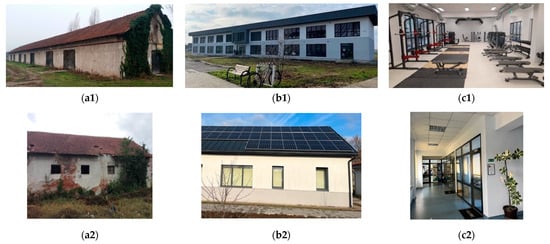
Figure 10.
Two cases of: (a1,a2) initial buildings—deposits; (b1,b2) retrofitted buildings; (c1,c2) research laboratory inside the renovated buildings.
3.4. Results following the Intervention on the Existing Hot Water Networks and following the Reconfiguration of the Heating System
The entire heating system of CUO has been reconfigured, rehabilitated, and made more efficient, resulting in two modern thermal plants (Figure 11) equipped with high-performance equipment with monitoring and control systems, geothermal water (renewable energy) being used/reused. Respectively, after the residual geothermal water from heating a part of the buildings, the resulting geothermal water is re-injected into the injection well.

Figure 11.
Thermal power plants: (a) geothermal laboratory; (b) laboratory of renewable energies.
With the rehabilitation solutions described above, the reduction of geothermal water consumption m3/m2 year is 21%, given that only 30% of the used spaces have been rehabilitated (according to the descriptions in Table 1) and, at the same time, only 10% of areas have been introduced into the circuit of education and research spaces.
4. Discussion
Since 2013, the University of Oradea has gradually integrated sustainable development strategies and actions into teaching, research, infrastructure, and campus operations.
The CUO’s management activity is focused on European decision makers and targets, with a focus on climate change policy. The actions and legislative packages issued by both the United Nations and the European Union form the framework for the proposed targets. In this legislative and geopolitical context presented, the UO’s management team is concentrating efforts to provide a sustainable education on a “green”, “healthy”, and sustainable campus. The term “Smart Campus” has been coined to describe projects that are being developed to raise funds. Part of the funding for these projects comes from the European Union, with funds coming from projects such as the Regional Operational Program (POR) 2014–2020. Priority Axis 10. Improving the educational infrastructure, Investment Priority 10.1. Investments in education and training, including vocational training, for the acquisition of skills and lifelong learning through the development of education and training infrastructure; Specific Objective 10.3. Increasing the relevance of university tertiary education in relation to the labor market and competitive economic sectors. As part of the “Smart Campus—University of Oradea” [44] project carried out under this financing, existing buildings were “recycled” through consolidation and “retrofitting”, the buildings were thermally and energetically rehabilitated, the investments committed to renovation of the buildings were from the existing construction stock (Figure 12).
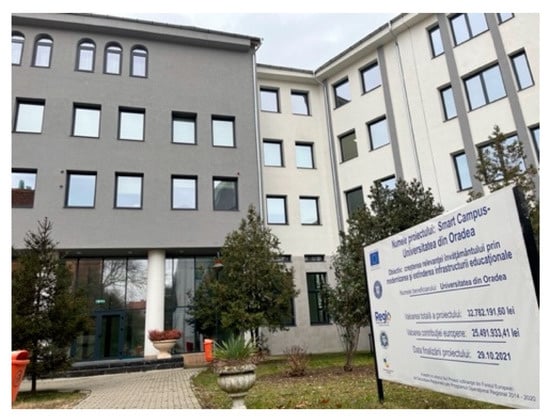
Figure 12.
“Smart Campus-UO”, European funding, 2020–2023.
Regarding the construction of a GB or the transformation of an existing building into a sustainable building, the authors of this study propose the scheme of approach highlighted in Figure 13. The proposal starts from the concept of a GB in the context of climate change and the circular economy, taking into account the solutions and results highlighted in the present work.

Figure 13.
Factors helping in obtaining a green building in the circular economy.
The image suggests the ideal case, namely construction concept designed and arranged on multiple levels, starting with the base:
- The legal framework, as well as management at the organizational level (state, administrative territorial units).
- A favorable economic environment (including funding, construction activity creditors) will play a decisive role in the realization of a sustainable construction or complex, but only in the context of a healthy and extensive educational and research system that would provide additional support.
- The ground floor of the designed building: with an adequate design and a specialized execution, depending on the financial power of the investors, the building will be able to meet the requirements of a sustainable one.
- The body of the projected building: GB, NZEB, and smart construction that is subject to the circular economy. Within the structure of the building, elements of composition and building equipment, building functions, mode of operation, and use are arranged on different levels.
- The designers (architects and engineers) must have the capacity to select the geometric shape of the building (a compact volume structure is recommended), to which they must associate a suitable envelope. Depending on the abilities of the designer/architect and the financial resources of the investor, the building should ideally be projected in such a way that it can easily be adapted to other functions—with minimal financial implications.
- The architectural solutions and materials used will be sustainable and green, contributing to the creation of a healthy environment within the building. The building will be equipped to meet the performance and functionality requirements, with guaranteed consumption efficiency and renewable energy input taken into consideration. It is very important to prepare the building user for the administration and operation of a Smart building system. The quality of the comfort provided, the satisfaction of the occupants, the appearance and the identity imprinted on the building represent the parameters of the building’s functions and aesthetics. The initial cost of the building and the cost of its maintenance and operation are the parameters that become the focus of the beneficiary.
- The roof of the projected building is represented by the results of building operation: the amount of energy consumed, pollution, low carbon emissions, garbage, and ultimately the idea of post-use of the building—all in the context of circular economy and sustainability.
All the aforementioned data are suggested in conceiving a summarizing hybrid model for the design or conversion of an existing building into a sustainable building, as it is presented in Figure 14.
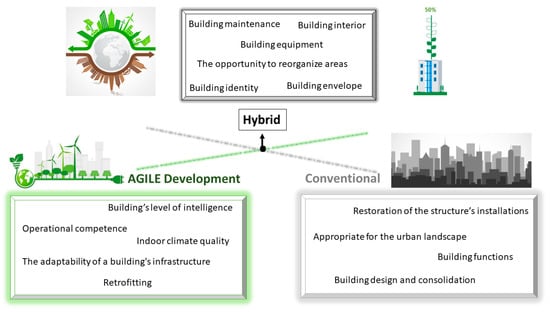
Figure 14.
Hybrid model for design or conversion of an existing building into a sustainable building.
In this theoretical hybrid approach, a conventional design and planning stage can be followed by an agile development process. Moreover, this approach allows for the development and execution of a detailed plan while providing adaptability in the implementation phase, maximizing the benefits of both strategies [45].
Climate change mitigation targets are set at international, European, and national levels. These are taken over in the development strategies of the territorial administrative units, in our case—in the development strategy of the UO. The present paper emphasizes that the defining elements, respectively the criteria for the certification of GB, settlements and further—of green university campuses are applicable and constitute an incentive for both beneficiaries and investors. By applying for certification in the UI Green Metric system [46,47], UO understood and directed its development strategy to meet the criteria of a “green” campus (Figure 15), to provide students and teachers with a healthy environment, to have a sustainable development, and to help combat climate change.
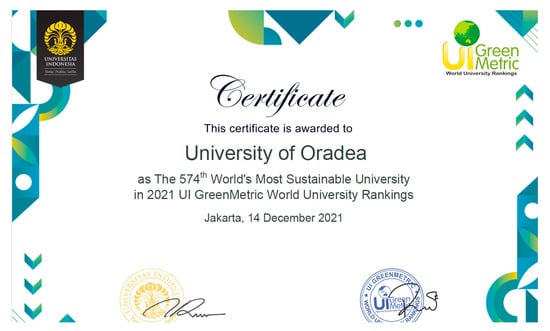
Figure 15.
UI Green Metric World University Rankings Certificate, from 2021.
To advance in this ranking, respectively to advance in the “Green” and “Heathy” development of its campus, UO will at least follow the criteria highlighted in this research, starting from the material/patrimonial components of the campus (buildings, land, equipment, endowments, utilities) reaching a holistic approach to education, student life on campus, educational and research activity and their results.
In this context, the UO has a very good collaboration with the local authorities. UO also initiated and responded to the request to enter clusters/consortia/alliances dedicated to sustainable/green development actions. The European Universities Alliance for Sustainability: responsible growth, inclusive education and environment (EU GREEN) can be mentioned here. The following nine universities are part of this alliance: University of Parma, Wroclaw University of Environmental and Life Sciences, University of Extremadura, Otto von Guericke University Magdeburg, University of Évora, University of Angers, University of Gävle, University of Oradea and Atlantic Technical University [48].
The actions for the sustainable development of an existing university campus and its orientation towards a “green” campus must be located on different levels highlighted in Figure 16. This scheme proposes a gradual holistic approach, starting from the simple material elements that define the campus and reaching its spirit and purpose. Thus, the challenges of a “green” campus address the site, the buildings, respectively the infrastructure, and the biodiversity by:
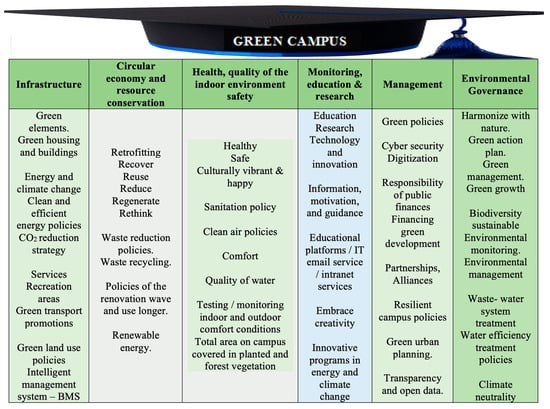
Figure 16.
New Green campus conceptual model including as promoting factor the clean infrastructure.
- –
- Furnishing and equipping the site with a special respect for nature and the natural;
- –
- The sense of safety created, the healthy ambience and the comfort in which the entire activity is carried out;
- –
- The quality of life inside the campus;
- –
- The services provided to students and teaching staff;
- –
- The educational and relational system offered by the research and innovation conditions created through technology transfer approaches [49,50].
All these principles and criteria are subject to the desire to ensure a future for the following generations, obeying the principles of the circular economy, enhancing adaptation to climate change, recovery, and green growth, obeying international and European policies.
The CUO redesign initiated and led to a framework that integrates strategies and complex solutions that cover buildings with multiple destinations (for education—laboratories and lecture halls, student dormitories, warehouses, offices, etc.). It should also be emphasized that it is specific to CUO that it contains buildings built throughout the last century, in different stages: 1910–1920, 1960–1970, as well as buildings built relatively recently, 1990–2000. Moreover, the constructions addressed originally had various functions, most of them different from the ones they have today. Another very special feature of CUO is the existence of geothermal water (renewable energy) that the campus benefits from as a heating agent.
It is undeniable that other already published papers have also evaluated and quantified the impact of modernizing university campuses [51,52,53]. However, their different approaches, the numerous differences between the campuses at the geoclimatic, architectural level, the construction materials used, the age of the buildings, the heating agent used, etc. make it very difficult to compare the results obtained. However, as a leitmotif, the positive impact of modernization, especially related to the consumption of thermal and electrical energy, but also on the communities served, respectively, the need for sustainable development, is emphasized in this research.
5. Conclusions
The study deepens the case of UO which is the beneficiary of renewable energy (geothermal water), used/reused as a heating agent and domestic hot water. In addition, the authors summarize the CUO heating/cooling principle, proposing it as an effective solution of sustainable development, for this type of location. With the intervention solutions on some of the buildings and networks of the university campus presented in the paper (energy efficiency, thermal efficiency, rehabilitation, renovation, retrofitting, modernization) a 20% reduction in the specific energy consumption for heating alone was obtained, under the conditions of a relevant contribution (10%) of educational spaces obtained through retrofitting. Corroborating all the interventions on the existing infrastructure described, it is obvious that the “wave of renovation” will contribute significantly to reach the targets set regarding sustainable development.
Through this paper, not only have we framed the “green” evolution of CUO, but we came up with new aspects compared to those presented in the specialized literature, namely:
- –
- The efficiency and modernization of some buildings, older than 100 years (heritage buildings), are described;
- –
- Buildings with various destinations (for students, professors, staff, and materials) are addressed in the same work;
- –
- Constructions changing their initial destination are presented;
- –
- A summarizing scheme depicting the main aspects which help in the construction of a GB or in the transformation of an existing building into a sustainable building (Figure 13);
- –
- A green campus conceptual model (Figure 16), including as a promoting factor the clean infrastructure (both for new and existing buildings, a coherent approach solution was provided, in the context of the circular economy, so that the result of the construction/intervention on the existing construction is that of a GB).
In addition, through the practical solutions presented, the study demonstrates that a “recipe”/solution for a “green” and “healthy” campus is the application of the principles enunciated in the policies of sustainable and “green” development on different levels. Regarding the case study brought to attention (CUO), as future directions, it would be the combination of thermal and energy efficiency solutions and the introduction of renewable energies from various sources, in order to reduce energy consumption and CO2 emissions. Finally, there is an obvious need to continue the management of this campus in a “green” vision, respectively to intensify the application of the principles and concepts synthesized for “green” development. It is noticeable that the solutions applied to CUO and presented in the paper can be taken over and adapted according to the specifics of each campus, considering the types of interventions on buildings, their age, original vs. final function, heating agent, etc.
Author Contributions
Conceptualization, C.C.B. and C.B.; Data curation, C.C.B. and I.F.P.-H.; Formal analysis, C.C.B. and M.T.T.; Investigation, C.C.B., I.F.P.-H. and T.B.; Methodology, C.C.B., C.B., T.B. and M.F.P.; Project administration, C.B. and M.F.P.; Resources, M.F.P.; Software, C.C.B. and D.E.P.; Supervision, C.B.; Validation, M.T.T. and M.F.P.; Visualization, C.C.B. and M.F.P.; Writing—original draft, C.C.B., I.F.P.-H. and T.B.; Writing—review & editing, C.C.B. and T.B. All authors have read and agreed to the published version of the manuscript.
Funding
This research received no external funding.
Institutional Review Board Statement
Not applicable.
Informed Consent Statement
Not applicable.
Data Availability Statement
The data used in the work are available within the General Administrative Directorate/Sustainable Campus Directorate//Investments and Consolidations Office and Heritage Office, of the University of Oradea, Romania, being included as appropriate: in the construction books, the technical documentation of construction interventions, the energy audits within them, the documents for the reception of the renovation works, the energy performance certificates drawn up at the initiation of the rehabilitation works and at their reception, the technical projects authorized and put into operation, as well as on the data basis of monitoring and controlling the utilities consumption within the University of Oradea.
Acknowledgments
The authors express their gratitude to the University of Oradea for providing the facilities required by this research.
Conflicts of Interest
The authors declare no conflict of interest.
References
- Zakaria, R.; Foo, K.S.; Zin, R.M.; Yang, J.; Zolfagharian, S. Potential Retrofitting of Existing Campus Buildings to Green Buildings. Appl. Mech. Mater. 2012, 178–181, 42–45. [Google Scholar] [CrossRef]
- Nguyen, H.D.; Macchion, L. Risk management in green building: A review of the current state of research and future directions. Environ. Dev. Sustain. 2022, 25, 2136–2172. [Google Scholar] [CrossRef]
- Berardi, U. A cross-country comparison of the building energy consumptions and their trends. Resour. Conserv. Recycl. 2017, 123, 230–241. [Google Scholar] [CrossRef]
- Darko, A.; Zhang, C.; Chan, A.P.C. Drivers for green building: A review of empirical studies. Habitat Int. 2017, 60, 34–49. [Google Scholar] [CrossRef]
- Ahmed, N.; Abdel-Hamid, M.; Abd El-Razik, M.M.; El-Dash, K.M. Impact of sustainable design in the construction sector on climate change. Ain Shams Eng. J. 2021, 12, 1375–1383. [Google Scholar] [CrossRef]
- Bogdan, A.; Chambre, D.; Copolovici, D.M.; Bungau, T.; Bungau, C.C.; Copolovici, L. Heritage Building Preservation in the Process of Sustainable Urban Development: The Case of Brasov Medieval City, Romania. Sustainability 2022, 14, 6959. [Google Scholar] [CrossRef]
- Wang, X.; Stewart, M.G.; Nguyen, M. Impact of climate change on corrosion and damage to concrete infrastructure in Australia. Clim. Change 2012, 110, 941–957. [Google Scholar] [CrossRef]
- Bungau, C.C.; Bungau, T.; Prada, I.F.; Prada, M.F. Green Buildings as a Necessity for Sustainable Environment Development: Dilemmas and Challenges. Sustainability 2022, 14, 13121. [Google Scholar] [CrossRef]
- Ahn, Y.H.; Pearce, A.R.; Wang, Y.; Wang, G. Drivers and barriers of sustainable design and construction: The perception of green building experience. Int. J. Sustain. Build. Technol. Urban Dev. 2013, 4, 35–45. [Google Scholar] [CrossRef]
- Zhai, Z.J.; McNeill, J.S. Roles of building simulation tools in sustainable building design. Build. Simul. 2013, 7, 107–109. [Google Scholar] [CrossRef]
- Cordero, E.C.; Centeno, D.; Todd, A.M. The role of climate change education on individual lifetime carbon emissions. PLoS ONE 2020, 15, e0206266. [Google Scholar] [CrossRef] [PubMed]
- Prada, M.; Popescu, D.; Bungau, C. Building Education, Source of Energy Saving in Romania. In Proceedings of the 15th National Technical-Scientific Conference on Modern Technologies for the 3rd Millennium, Oradea, Romania, 27–28 November 2015; pp. 157–162. [Google Scholar]
- COM/2019/640. Communication from the Commission to the European Parliament, the European Council, the Council, the European Economic and Social Committee and the Committee of the Regions. The European Green Deal. Available online: https://eur-lex.europa.eu/legal-content/EN/TXT/HTML/?uri=CELEX:52019DC0640&from=EN (accessed on 2 February 2023).
- COM/2020/80. Proposal for a Regulation of the European Parliament and of the Council Establishing the Framework for Achieving Climate Neutrality and Amending Regulation (EU) 2018/1999 (European Climate Law). Available online: https://eur-lex.europa.eu/legal-content/EN/TXT/HTML/?uri=CELEX:52020PC0080&from=EN (accessed on 2 February 2023).
- Mahdee, J.; Abu Bakar, N.; Oh, V.; Seng, K. Green campus universities: Case studies on problems and prospects. F1000Research 2022, 11, 1200. [Google Scholar] [CrossRef]
- Ilies, M.; Ilies, D.C.; Ilies, A.; Josan, I.; Ilies, G. The gateway of Maramureş land: Geostrategical implications in space and time. Ann. Ser. Hist. Sociol. 2010, 20, 469–480. [Google Scholar]
- Noor, S.N.A.M.; Loong, L.K.; Naamandadin, N.A. An Insight of Challenges in Implementing Green Campus: ACase Study of Universiti Malaysia Perlis. J. Adv. Res. Eng. Knowl. 2019, 7, 34–40. [Google Scholar]
- Li, B.; Zhao, X.; Luo, Y. Design Strategies for Green Retrofitting of a University Student Dormitory in the Hot-humid and Less-windy Climate. In Proceedings of the 2022 International Conference on Green Building, Civil Engineering and Smart City; Springer Nature: Singapore, 2022; Volume 211, pp. 22–31. [Google Scholar]
- Herman, G.V.; Caciora, T.; Ilies, D.C.; Ilies, A.; Deac, A.; Sturza, A.; Sonko, S.M.; Suba, N.S.; Nistor, S. 3D Modeling of the Cultural Heritage: Between Opportunity and Necessity. J. Appl. Eng. Sci. 2020, 10, 27–30. [Google Scholar] [CrossRef]
- Grama, V.; Ilies, G.; Safarov, B.; Ilies, A.; Caciora, T.; Hodor, N.; Ilies, D.C.; Kieti, D.; Berdenov, Z.; Josan, I.; et al. Digital Technologies Role in the Preservation of Jewish Cultural Heritage: Case Study Heyman House, Oradea, Romania. Buildings 2022, 12, 1617. [Google Scholar] [CrossRef]
- Tsantili, A.; Koronaki, I.; Polydoros, V. Maximizing Energy Performance of University Campus Buildings through BIM Software and Multicriteria Optimization Methods. Energies 2023, 16, 2291. [Google Scholar] [CrossRef]
- Carbonara, E.; Tiberi, M. Assessing Energy Performance and Economic Costs of Retrofitting Interventions in a University Building. In Proceedings of the EEEIC 2016—International Conference on Environment and Electrical Engineering, Florence, Italy, 7–10 June 2016; IEEE: Piscataway, NJ, USA, 2016; pp. 1–5. [Google Scholar]
- Prada, M.; Popescu, D.E.; Bungau, C.; Pancu, R. Parametric Studies on European 20-20-20 Energy Policy Targets in University Environment. J. Environ. Prot. Ecol. 2017, 18, 1146–1157. [Google Scholar]
- University of Oradea. Satellite Image. Available online: https://latitude.to/articles-by-country/ro/romania/71587/university-of-oradea (accessed on 2 February 2023).
- University of Oradea—Former Gendarmerie School Vágó József. Available online: http://enciclopediavirtuala.ro/monument.php?id=186 (accessed on 2 February 2023).
- National Heritage Institute. List of Historical Monuments in Romania. Available online: https://patrimoniu.ro/monumente-istorice/lista-monumentelor-istorice (accessed on 14 February 2023).
- Infographic—Renovation Wave: Creating Green Buildings for the Future. Available online: https://www.consilium.europa.eu/en/infographics/renovation-wave/ (accessed on 27 December 2022).
- University of Oradea. Google Maps. Available online: https://www.google.com/maps/place/Universitatea+din+Oradea/@47.0446787,21.9179081,17z/data=!4m6!3m5!1s0x4746479564d81847:0xda97ccf1bcea0869!8m2!3d47.0446751!4d21.9201021!16zL20vMDU4NWow (accessed on 15 January 2023).
- Tivadar, D.; Cristea, M. Energy Audit—Documentation for the Approval of Intervention Works on Building E–F; University of Oradea: Oradea, Romania, 2018; p. 20. [Google Scholar]
- Tivadar, D.; Cristea, M. Energy Audit; University of Oradea: Oradea, Romania, 2020; p. 20. [Google Scholar]
- Csizmadia, Z. Energy Audit—Technical Project-Rehabilitation of Pavilion P and Gym-Building C 20; University of Oradea: Oradea, Romania, 2018; pp. 13–21. [Google Scholar]
- Sabau, E. Energy Performance Certificate; University of Oradea: Oradea, Romania, 2022; p. 1. [Google Scholar]
- Năstase, R.P. Masterplan for the University Campus of Oradea through Oradea City Hall. Available online: https://www.anuala.ro/en/projects/2019/196/ (accessed on 10 February 2023).
- Bungău, C.C.; Prada, I.F.; Prada, M.; Bungău, C. Design and Operation of Constructions: A Healthy Living Environment-Parametric Studies and New Solutions. Sustainability 2019, 11, 6824. [Google Scholar] [CrossRef]
- IT Infrastructure: Forging the Future Efficiently and Sustainably. IT Solutions for Companies. Available online: https://www.green.ch/en/blog/detail/it-infrastructure-forging-the-future-efficiently-and-sustainably (accessed on 24 January 2023).
- Popescu, D.E.; Prada, M.F.; Dodescu, A.; Hemanth, D.J.; Bungau, C. A Secure Confident Cloud Computing Architecture Solution for a Smart Campus. In Proceedings of the 7th International Conference on Computers Communications and Control, ICCCC, Oradea, Romania, 8–12 May 2018; IEEE: Piscataway, NJ, USA, 2018; pp. 240–245. [Google Scholar]
- Popescu, D.E.; Bungau, C.; Prada, M.; Domuta, C.; Bungau, S.; Tit, D.M. Waste management strategy at a public university in smart city context. J. Environ. Prot. Ecol. 2016, 17, 1011–1020. [Google Scholar]
- Tit, D.M.; Bungau, S.G.; Nistor-Cseppento, D.C.; Copolovici, D.M.; Buhas, C.L. Disposal of unused medicines resulting from home treatment in Romania. J. Environ. Prot. Ecol. 2016, 17, 1425–1433. [Google Scholar]
- Bungau, S.G.; Suciu, R.N.; Bumbu, A.G.; Cioca, G.; Tit, D.M. Study on Hospital Waste Management in Medical Rehabilitation Clinical Hospital, Baile Felix. J. Environ. Prot. Ecol. 2015, 16, 980–987. [Google Scholar]
- Tivadar, D.; Cristea, M. SMART Campus Project. Technical Project within the SMART Campus Project; University of Oradea: Oradea, Romania, 2020; p. 1. [Google Scholar]
- Tivadar, D.; Cristea, M. Energy Efficiency of D Building; Technical Project; University of Oradea: Oradea, Romania, 2020; p. 1. [Google Scholar]
- Prada, M. Energy Audit—Feasibility Study within the Project “Infrastructure for Research in Smart Spaces and Energy Efficient Processes”; University of Oradea: Oradea, Romania, 2013; pp. 19–32. [Google Scholar]
- Cristea, M. Energy Performance Certificate at Building Reception; SMART Campus Project; University of Oradea: Oradea, Romania, 2022; p. 1. [Google Scholar]
- Regional Operational Programme 2014–2020, North-West Region of Romania, Northern Transylvania. Available online: https://www.nord-vest.ro/wp-content/uploads/2017/09/Brosura-POR.pdf (accessed on 15 January 2023).
- Lalmi, A.; Fernandes, G.; Souad, S.B. A conceptual hybrid project management model for construction projects. Procedia Comput. Sci. 2021, 181, 921–930. [Google Scholar] [CrossRef]
- UI GreenMetric. Overall Rankings 2022. Available online: https://greenmetric.ui.ac.id/rankings/overall-rankings-2022 (accessed on 15 January 2023).
- UI GreenMetric World University Rankings. Available online: https://chancellery.utm.my/sustainable/ui-greenmetric/ (accessed on 8 January 2023).
- European Universities Alliance for Sustainability: Responsible Growth, Inclusive Education and Environment (EU GREEN). Available online: https://www.eugreenalliance.eu/ (accessed on 15 January 2023).
- Craiut, L.; Bungau, C.; Negru, P.A.; Bungau, T.; Radu, A.-F. Technology Transfer in the Context of Sustainable Development—A Bibliometric Analysis of Publications in the Field. Sustainability 2022, 14, 11973. [Google Scholar] [CrossRef]
- Craiut, L.; Bungau, C.; Bungau, T.; Grava, C.; Otrisal, P.; Radu, A.F. Technology Transfer, Sustainability, and Development, Worldwide and in Romania. Sustainability 2022, 14, 15728. [Google Scholar] [CrossRef]
- Chen, G.; Cheng, L.; Li, F. Integrating Sustainability and Users’ Demands in the Retrofit of a University Campus in China. Sustainability 2022, 14, 10414. [Google Scholar] [CrossRef]
- Eldin, S.S.; Elwan, M.M.; Bayoumi, A.A. Retrofitting Campus Outdoor Space Based on Thermal Performance: Case Study Seberbay University Campus, Tanta City. Civ. Eng. Archit. 2021, 9, 2505–2516. [Google Scholar] [CrossRef]
- Aboulnaga, M.; Wanas, A.; Hammad, M.; Hussein, M. Sustainability of Higher Educational Buildings: Retrofitting Measures to Enhance Energy Performance—The Case of AASTMT Business Management School Building, Egypt. In Mediterranean Green Buildings and Renewable Energy: Selected Papers from the World Renewable Energy Network’s Med Green Forum; Springer International Publishing: Cham, Switzerland, 2017; pp. 117–150. [Google Scholar]
Disclaimer/Publisher’s Note: The statements, opinions and data contained in all publications are solely those of the individual author(s) and contributor(s) and not of MDPI and/or the editor(s). MDPI and/or the editor(s) disclaim responsibility for any injury to people or property resulting from any ideas, methods, instructions or products referred to in the content. |
© 2023 by the authors. Licensee MDPI, Basel, Switzerland. This article is an open access article distributed under the terms and conditions of the Creative Commons Attribution (CC BY) license (https://creativecommons.org/licenses/by/4.0/).